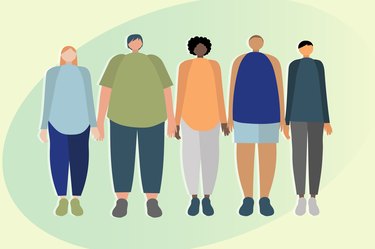
Gender-affirming care refers to any treatment or procedure done to help people dealing with the effects of gender dysphoria, or the intense conflict of identifying as a different gender from what they were assigned to at birth. And while this kind of care is exceptionally important for the health and safety of transgender and gender-nonconforming people, it can be difficult to access.
Gender-affirming care can include hormone therapy and transition surgery, but it also incorporates primary care, according to the U.S. Department of Health and Human Service's Office of Population Affairs.
Video of the Day
Video of the Day
And it's important to work with a gender-affirming provider to receive this care, as they understand (and can address) how transitioning affects all aspects of a person's health.
But while acceptance has come a long way, there are still many barriers that prevent transgender and gender-nonconforming folks from receiving the care they need. Here are some of the most common obstacles to gender-affirming care, plus how to deal with them.
1. Geography
The first step to accessing gender-affirming care is finding the right provider. But sometimes, that's not possible.
Some folks simply don't have trans-inclusive health care in their area, says Jerrica Kirkley, MD, founder of Plume. "Especially if one lives in a rural area, it may be hard to find skilled providers around you," she adds.
2. Harassment
On that note, transgender people living in more rural areas may only have access to traditional clinics, where they run the risk of discrimination or harassment, Dr. Kirkley says.
For example, a doctor may refuse to use the person's correct pronouns, which can result in emotional damage and complicate the effectiveness of provided care.
And even those who do have gender-affirming clinics nearby may be discouraged from visiting them due to physical or emotional harassment they encounter in these clinics or during their commute to them.
Planned Parenthood, for instance, is known for providing gender-affirming care. However, many clinics have protestors outside who harass those who come to receive treatment, Dr. Kirkley says.
3. Insurance
Insurance can be confusing in even the most straightforward medical situations. And transition-related coverage can be all the more complicated.
For starters, "patients often are unaware that their insurance covers gender-affirming surgery," says Wendy Ng, MD, a California-based plastic surgeon who performs gender-affirming top surgery.
And that's just the beginning: Treatment requirements can change depending on the specifics of a person's coverage, provider or state where care is given.
For example, certain insurance plans don't require an individual to be on hormone therapy before receiving certain gender-affirming surgical procedures, while others do, Dr. Ng says. Likewise, surgical providers may have weight restrictions that disqualify some individuals from surgery.
4. Cost
Gender-affirming care can also be pricey, both with and without insurance.
For instance, medically transitioning can cost upwards of $22,000 out of pocket, per April 2016 research in the Journal of General Internal Medicine, which isn't financially feasible for many people.
Tip
The same study concluded that gender-affirming surgery and care is both helpful and cost-effective in the long run, as it decreases the risk for HIV, depression, suicidal ideation and substance misuse.
5. Lack of Information
"Patients are also unaware of [the World Professional Association for Transgender Health (WPATH)] guidelines for gender-affirming care, which include evaluation by a mental health professional," Dr. Ng says.
The WPATH is an interdisciplinary organization designed to promote transgender health. It provides nationally agreed-upon standards for trans health care to guide clinics across the country.
These guidelines outline how health care providers ought to approach psychiatric, psychological, medical and surgical treatment of transgender people, according to the WPATH.
However, most transgender folks seeking medical care aren't even aware that these standards exist, Dr. Ng says. This is the opposite of empowering: It makes it difficult for trans people to know what to expect and ask for during treatment.
Tip
Search the WPATH's provider directory to find quality gender-affirming care near you.
6. Lack of Support
Family support can mean the difference between folks seeking care or avoiding it altogether. It's especially important for minors, who aren't legally old enough to make major decisions about their health care.
"A lack of family support, specifically for trans+ minors, can result in delayed or denied access to gender-affirming hormones or puberty blockers," Laura Obert, PhD, licensed psychologist and LGBTQ coach, tells LIVESTRONG.com.
Inadequate support from loved ones can also be difficult for gender-diverse adults — it may also discourage people from continuing care or seeking it out in the first place.
7. Lack of Representation
If trans people can't see others like them, it's easy to think they don't have options.
"There's a lack of conversation at home, school and work about the fact that trans+ people are actually living and functioning at all levels of society," Obert says. "This can prevent some trans+ folks from seeing versions of themselves reflected in the everyday fabric of life, leading to a sense of isolation."
Representation requires uncomfortable conversations and challenging current societal structures — all of which are crucial to ensure that gender-diverse people get the care and support they deserve.
How to Overcome Barriers to Gender-Affirming Care
These obstacles are serious and prevent many trans folks from receiving care. Fortunately, all of us can work to help break down these barriers.
1. Do Your Research
Education — about insurance, medical procedures and trans health in general — is one of the best ways to help gender-diverse people receive the care they need, Obert says.
"I teach my clients to screen for basic information that can be found on a provider's form, paperwork, website or organization's information," Obert says. This empowers people to access the information they need to make an informed decision about their health care.
2. Shop for Doctors
Obert also recommends screening doctors before setting up a first appointment.
"I encourage [my clients] to call and ask providers how many trans patients they have worked with and if they are open to an initial 10- to 20-minute consultation, free of charge," Obert says.
3. Build Community
Having a support system can mean the difference between getting necessary care and developing health problems, Obert says.
For those who don't currently have a strong network, local pride centers can help provide all kinds of aid, including resources to support your social life, mental health, physical wellbeing, housing situation and more.
Even if your local center doesn't have the resources to deal with a particular problem, they'll likely know who does — most pride centers are dialed into the needs of their community and can refer you to a trusted person or organization who can better address your specific needs.
Tip
Looking for a local pride center? Check out this LGBTQ Centers directory to find one close to you.
4. Try Telehealth Care
Within the last decade, telehealth visits have made gender-affirming care more available to folks across the country, including those who are geographically distant from trans-friendly clinics.
"The ability to receive care on your device from medical professionals who are experts in gender-affirming care diminishes barriers that those in the transgender community often face," Dr Kirkley says. Here's how to get started with teletherapy.
- LGBT Centers: "CenterLink"
- U.S. Department of Health and Human Services Office of Population Affairs: "Gender-Affirming Care and Young People"
- World Professional Association for Transgender Health: "Mission and Vision"
- World Professional Association for Transgender Health: "Provider Directory Search"
- Journal of General Internal Medicine: "Societal Implications of Health Insurance Coverage for Medically Necessary Services in the U.S. Transgender Population: A Cost-Effectiveness Analysis"
Is this an emergency? If you are experiencing serious medical symptoms, please see the National Library of Medicine’s list of signs you need emergency medical attention or call 911.


